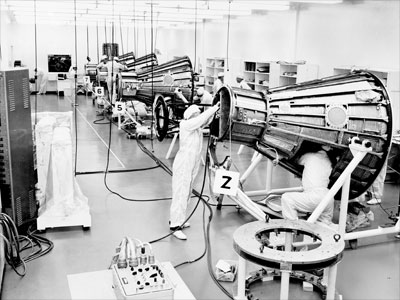Their contributions to Project Mercury in the early days of the space race went largely unrecognized, as their vision and accomplishments were overshadowed by program's historic moments.
But on Feb. 25, the McDonnell Aircraft team of retired engineers and technicians who designed and built the Mercury spacecraft that carried Americans into space for the first time, were finally honored in St. Louis.
The Institute of Electrical & Electronics Engineers (IEEE), the world's largest professional association for technology advancement, recognized Boeing with an IEEE Milestone award in electrical engineering and computing for the Mercury spacecraft.
Moshe Kam, IEEE president, told an audience largely made up of retired Project Mercury engineers that time had not forgotten their contributions.
"The often nameless, the often somewhat forgotten technicians, engineers, physicists, mathematicians and other thinkers and doers from whose imaginations and minds enhance this spectacular achievement - we came today to acknowledge what you have done and to commemorate it," said Kam.
A marker, shaped like the Mercury space capsule that carried John Glenn, the first American to orbit the Earth in 1962, was unveiled during the ceremony. Many of the Mercury engineering team members gathered in Boeing's Prologue Room in St. Louis to pose for pictures in front of a Mercury capsule they designed and built almost 50 years ago.
"It was a small, tight-knit organization," said Ron Schutz, a retired McDonnell Aircraft electrical engineer who worked on Mercury's communications systems.
Holding an original Mercury flight operations manual similar to the ones each astronaut carried on their flights into space, Allan Nelson remembered the early days at Cape Canaveral, Fla., in the 1960s and the pioneering work they did that helped put the first man on the moon.
"We didn't go down there [Florida] for money, we went down there to make sure to get this thing done and to get our guys up in space and to get them back unharmed," said Nelson.
Nelson's wife Ann also remembered those days and the first U.S. manned space flight.
"I'll never forget it, if I close my eyes I can see it today," she said. "[Mercury astronaut] Alan Shepard] going up. I stood in the front yard in our little duplex with tears. He was my hero."
The work done by the Boeing heritage company McDonnell Aircraft engineers still surprises some close to the project. Peering into the hatch of the Mercury capsule used for design and engineering purposes by the Mercury astronauts, retired engineer Ed Klein looked at the exposed wire bundles behind the instrument panel.
"When you look at that circuitry by today's standard, that is so crude, but it worked," Klein laughed.
In 1963, Mercury was the first program a young McDonnell Aircraft engineer named John Van Gels worked on with the company. Today, as Boeing Defense, Space & Security (BDS) vice president of strategic planning for Operations and Supplier Management, he told his former teammates that together they made history.
"We were the first people to design, assemble and deliver an unmanned American spacecraft into space," said Van Gels. "And that heritage continues every day."
Dennis Muilenburg, BDS president and CEO, said the Mercury engineers also continue to inspire a new generation.
"We are investing significantly in science, technology, engineering and math (STEM), and encouraging children to get into STEM careers understanding the importance of science and technology to our country," Muilenburg said.
After the event, engineer Ron Schutz walked quietly through the Prologue Room staring at the capsule he had worked on so many years before.
Each of the Mercury engineers in attendance carried the same trait to the milestone event - humility - for the work they had done on America's first manned space flight program.
"We really felt we were doing something big back then," Schutz quietly said. "There is a lot of soul in that spacecraft."












